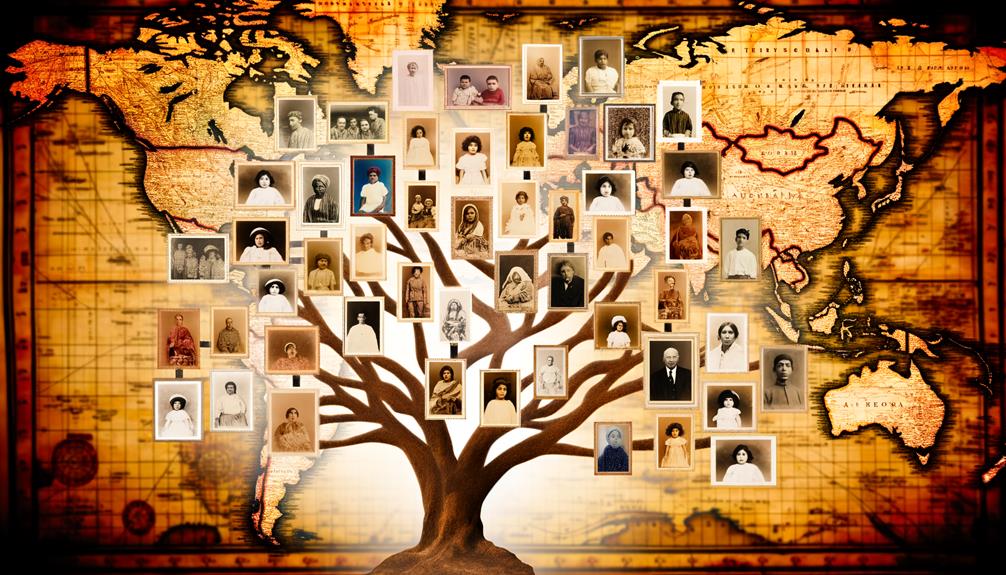Family Name Meaning and Origin
Family names, or surnames, offer a rich tapestry of historical significance, revealing lineage, social status, and occupation. Originating in ancient civilizations, such as Rome and China, surnames helped establish familial hierarchies and social structures.
In medieval Europe, they became essential for identification as populations grew. Occupational surnames like Smith or Baker depicted essential professions, while geographic names such as Hill and Wood denoted natural surroundings.
Patronymic and matronymic systems indicated lineage in various cultures, such as Scandinavian and Russian traditions. Over time, migrations and legal mandates have shaped and preserved these identifiers.
Discover the fascinating evolution and cultural intricacies that surnames encapsulate.

Key Takeaways
- Surnames often originated from occupations, indicating the profession of the first bearer, like Smith or Baker.
- Geographic surnames like Hill or Brook reflect the natural surroundings or settlement origins of the family.
- Patronymic and matronymic names, such as Johnson or Ivanovich, denote lineage from a parent.
- Descriptive surnames, such as Brown or Short, highlight physical attributes or characteristics of the original bearer.
- The evolution of surnames involves phonetic changes due to migrations and cultural integrations over time.
Historical Significance of Surnames
The historical significance of surnames can be traced back to ancient civilizations, where they emerged as a means to signify lineage, occupation, and social status. In ancient Rome, for instance, the use of the nomen and cognomen helped distinguish individuals within larger familial structures, reflecting both heritage and societal rank.
Similarly, in China, the establishment of family names during the Shang Dynasty served to denote lineage and ancestral roots, reinforcing familial hierarchies. Medieval Europe saw the adoption of surnames as populations grew and administrative needs intensified, providing a systematic way to identify individuals.
These early uses of surnames were instrumental in the development of social structures, aiding in the organization of societies and the establishment of legal and property rights.
Occupational Origins
How did surnames derived from occupations become a cornerstone of identity in various cultures throughout history?
Occupational surnames have their roots in the medieval period when professions became hereditary and crucial to community structure.
Names like Smith, Baker, and Taylor indicate professions essential to daily life and societal functioning.
These names served not only as identifiers but also as indicators of social roles and economic status.
They facilitated trade and commerce by providing an immediate understanding of the services one could offer.
Moreover, occupational surnames often reflected the skills and craftsmanship passed down through generations, becoming a source of familial pride.
Their prevalence across diverse cultures underscores their universal significance in shaping individual and collective identities.
Topographical and Geographical Roots
The origins of many family names can be traced back to the physical landscape and geographical features that were prominent when surnames first became hereditary. For example, the surname Moore likely had its origins in an area with a prominent moor or bog. The meaning and origin of Moore comes from the Middle English word “moor,” which referred to a marshy or fenland area. As families settled in different regions, they often adopted surnames that reflected the landscape and environment around them, making the study of surname origins a fascinating way to learn about local history and geography.
These landscape-based surnames, such as Hill, Brook, or Wood, often indicated the natural surroundings of a family's residence.
Moreover, geographic naming conventions frequently reflected the broader regional or cultural attributes, offering insights into historical settlement patterns and environmental influences on identity.
Landscape-Based Surnames
Rooted in the natural features of the landscape, many surnames derive from topographical elements such as hills, rivers, forests, and valleys, reflecting the geographical origins and the environmental interactions of early ancestors.
Names like 'Hill,' 'Brook,' 'Wood,' and 'Dale' provide a historical snapshot of where families lived or the natural features they were associated with. These surnames often emerged in medieval times when communities were small, and descriptors were necessary for identification.
For instance, 'Atwood' indicates proximity to a forest, while 'Underhill' suggests residence below a hill. Such surnames not only serve as identifiers but also preserve a legacy of human interaction with the environment, offering insights into the settlement patterns and lifestyles of historical populations.
Geographic Naming Conventions
Geographic naming conventions, deeply embedded in the etymology of surnames, expose a rich tapestry of historical settlement patterns and human interactions with the natural environment. These conventions often reflect the topographical features of ancestral homelands, providing insight into the landscapes that shaped early communities. For instance, the surname 'Hill' denotes a residence near a hill, while 'Ford' signifies proximity to a river crossing. Examining these naming traditions reveals significant cultural and environmental influences.
| Surname | Origin | Meaning |
|---|---|---|
| Hill | English | Residence near a hill |
| Ford | English | Dweller near a river crossing |
| Wood | English | Inhabitant near a forest |
Such surnames act as living records, preserving the interplay between geography and human habitation.
Patronymic and Matronymic Names
Patronymic and matronymic names, rooted in historical naming practices, reflect a lineage-based approach to family identity where names are derived from a parent's given name.
These practices, often gender-specific, were prevalent in various cultures, with patronymics being more common and matronymics appearing less frequently.
This tradition not only underscores the social structures of past societies but also highlights the evolution of naming conventions over time.
Historical Naming Practices
Throughout history, the practice of deriving family names from a parent's given name, known as patronymic and matronymic naming, has been a common method of identifying lineage and heritage in various cultures. This method, rooted in ancient traditions, provided a clear lineage identifier and facilitated societal organization.
In Scandinavia, for example, names ending in '-son' or '-dottir' indicated the child of a father or mother, respectively. Similarly, Russian patronymics, like Ivanovich or Ivanovna, denote descent from a male named Ivan. By examining these naming conventions, one gains insight into familial structures and inheritance patterns.
Over centuries, such practices have evolved but continue to underscore the profound connection between identity and ancestry.
Gender-Specific Name Origins
In many cultures, the origins of gender-specific names, such as those stemming from patronymic and matronymic traditions, reveal intricate patterns of societal norms and familial hierarchies. Patronymic names, derived from the father's first name, and matronymic names, derived from the mother's first name, offer a historical lens into the lineage and gender roles within various societies.
This naming practice can be illustrated through:
- Scandinavian Tradition: Names like 'Anderson' (son of Anders) and 'Olafsdóttir' (daughter of Olaf) reflect parental lineage.
- Russian Convention: Names such as 'Ivanov' (son of Ivan) and 'Ivanova' (daughter of Ivan) denote paternal heritage.
- Icelandic Custom: Names like 'Jónsson' (son of Jón) and 'Jónsdóttir' (daughter of Jón) highlight a strong patronymic tradition.
These examples underscore the deep-rooted cultural significance of gender-specific names.
Descriptive and Characteristic Surnames
Descriptive and characteristic surnames often originated from physical attributes, professions, or traits of the individual, providing a fascinating lens through which to explore historical and social contexts. These surnames offer insight into the lives and environments of our ancestors, reflecting their occupations, physical traits, or notable characteristics. For instance, the surname 'Smith' denotes a blacksmith, highlighting the occupation's prominence. Similarly, surnames like 'Brown' or 'Short' capture physical traits.
| Surname | Origin Explanation |
|---|---|
| Smith | Blacksmith occupation |
| Brown | Hair or skin color |
| Short | Physical stature |
| Baker | Profession of baking |
Understanding these surnames enhances our comprehension of societal structures and individual identities in historical contexts.
Cultural and Ethnic Influences
The examination of surnames reveals that cultural and ethnic influences have played a significant role in shaping family names, adding layers of meaning and historical context that reflect the diverse origins and migrations of populations.
These influences can be seen in various ways:
- Geographical Roots: Surnames often derive from a family's place of origin, such as 'London,' indicating an English heritage.
- Occupational Significance: Many surnames reflect the trades or professions of ancestors, like 'Smith' or 'Baker,' which underscore societal roles within specific ethnic groups.
- Patronymic and Matronymic Systems: Cultures like Norse and Slavic often used a system where surnames are derived from the given names of fathers or mothers, e.g., 'Andersen' or 'Ivanov.'
These elements underscore the intricate tapestry of cultural identity embedded in surnames.
Evolution of Surnames Over Time
Tracing the evolution of surnames over time reveals a complex narrative of linguistic shifts, legal mandates, and social customs that have collectively shaped the way family names are formed and perpetuated.
Initially, surnames were often descriptive, indicating occupation (e.g., Smith), lineage (e.g., Johnson), or geographic origin (e.g., Hill).
The 12th century saw European legal systems mandate surnames for taxation and identification purposes.
Over centuries, migrations and cultural integrations led to phonetic and orthographic changes.
The Industrial Revolution further standardized surnames to accommodate burgeoning bureaucratic needs.
Today, globalization and digitalization continue to influence surname development, introducing new naming conventions and preserving traditional ones.
This intricate evolution underscores the dynamic interplay between language, law, and society in surname formation.
Conclusion
In the grand tapestry of human history, surnames serve as both a mirror and a mosaic, reflecting occupations, landscapes, lineage, and characteristics. They unravel the intricate threads of cultural and ethnic influences, transforming simple labels into profound narratives.
With every evolution, these names capture the essence of societal shifts and personal identities. Hence, surnames, in their multifaceted glory, stand as enduring proofs to the ever-changing yet perpetual quest for identity and belonging.






